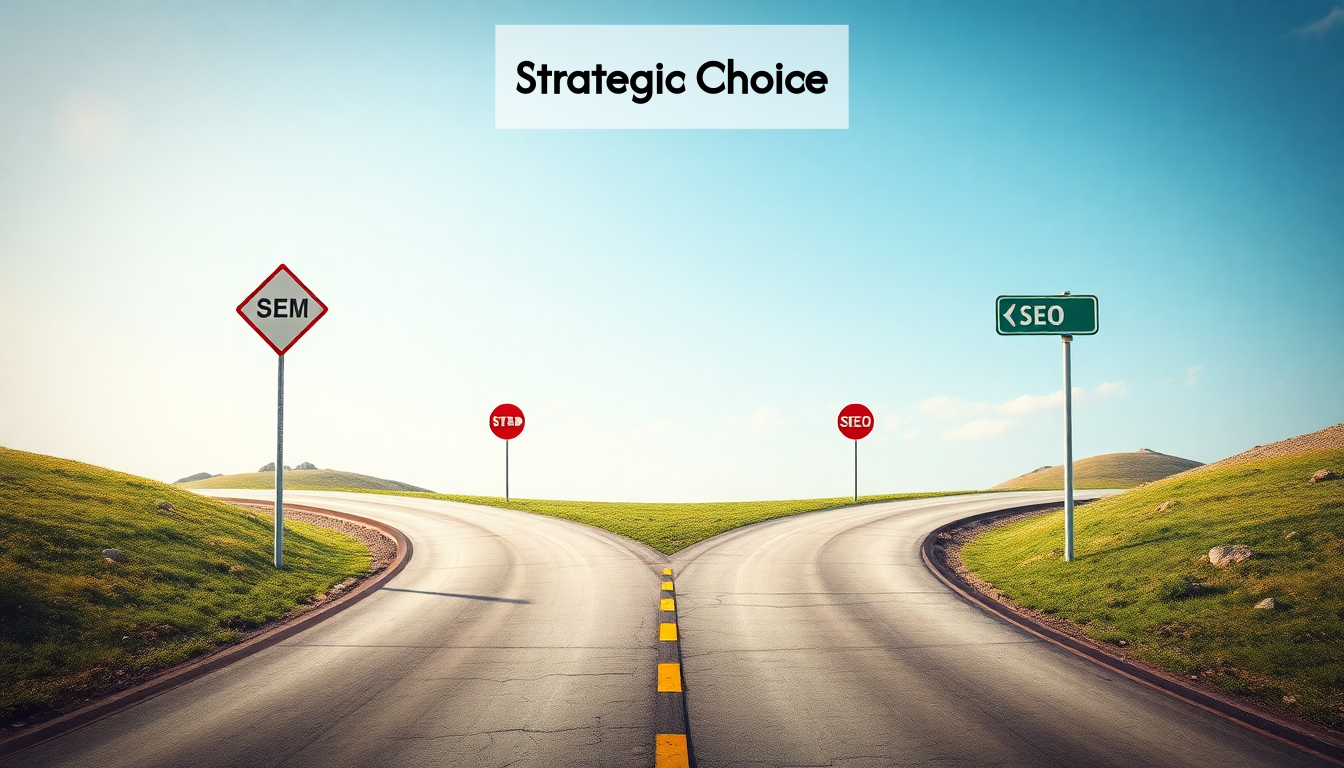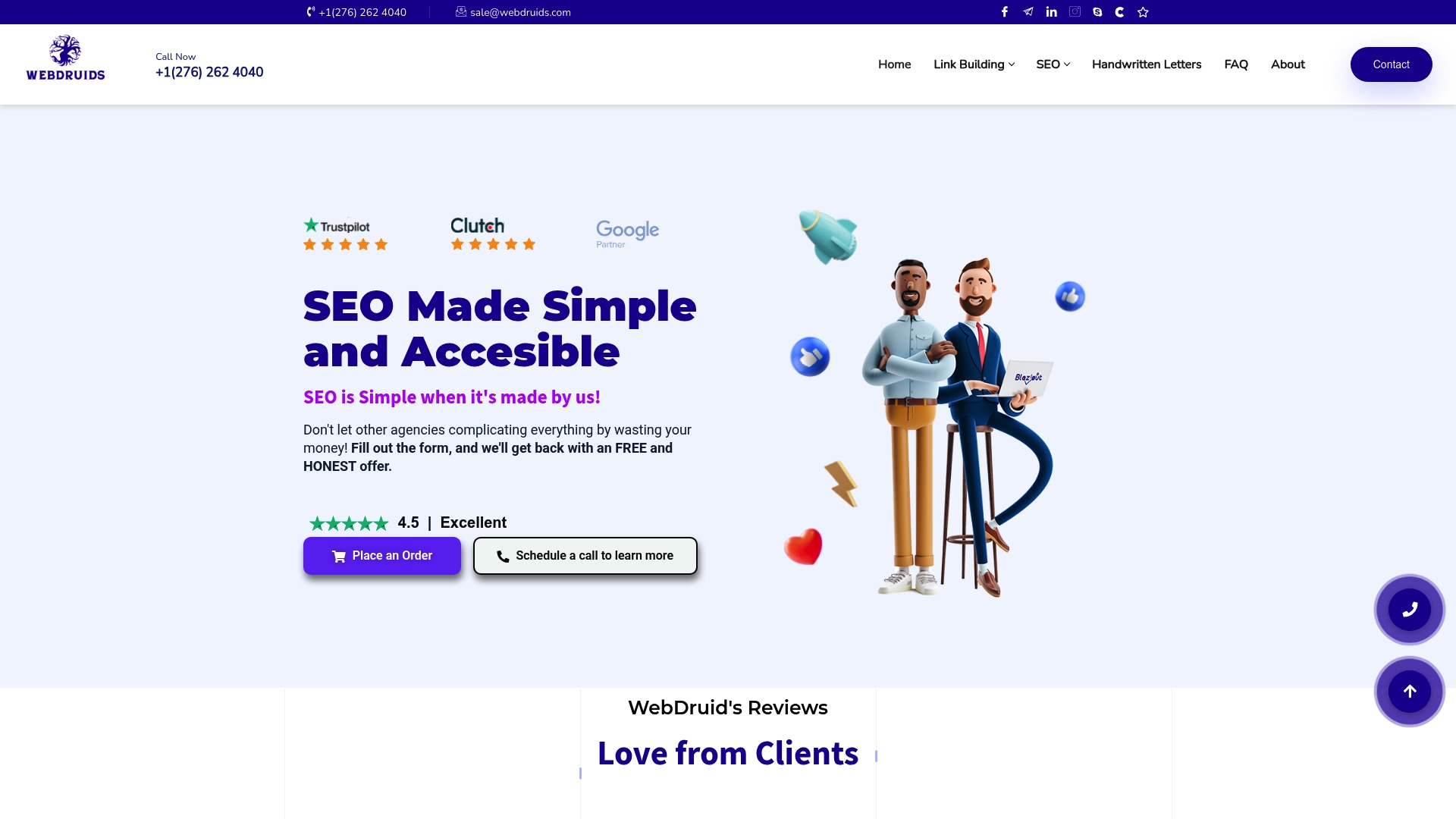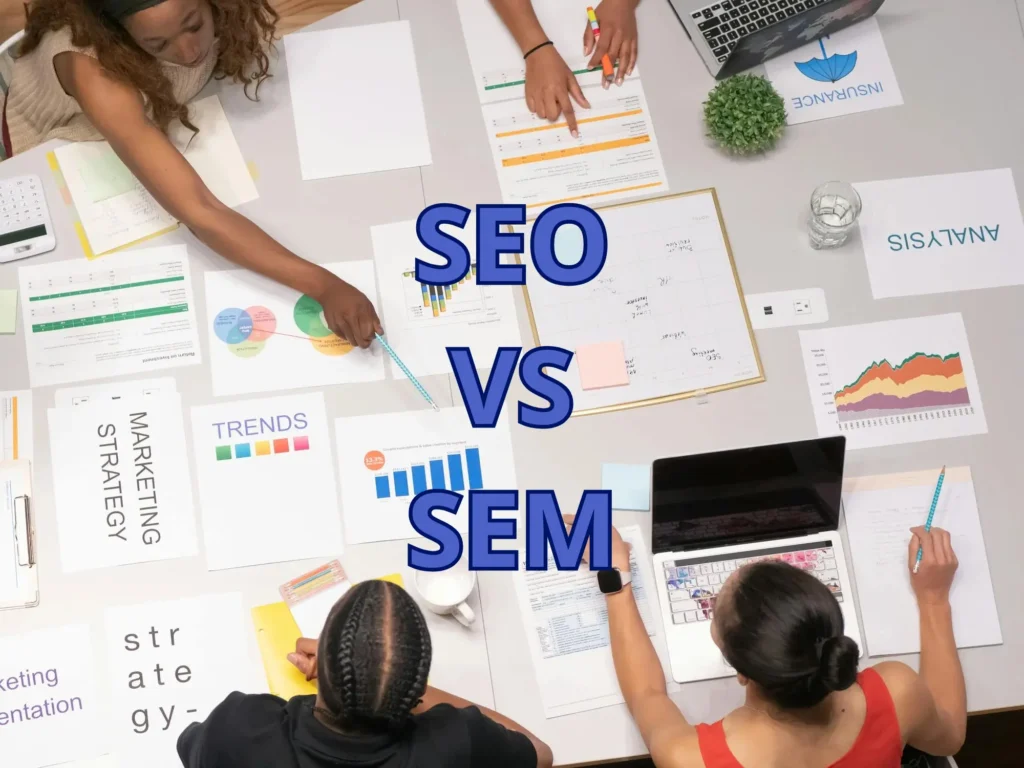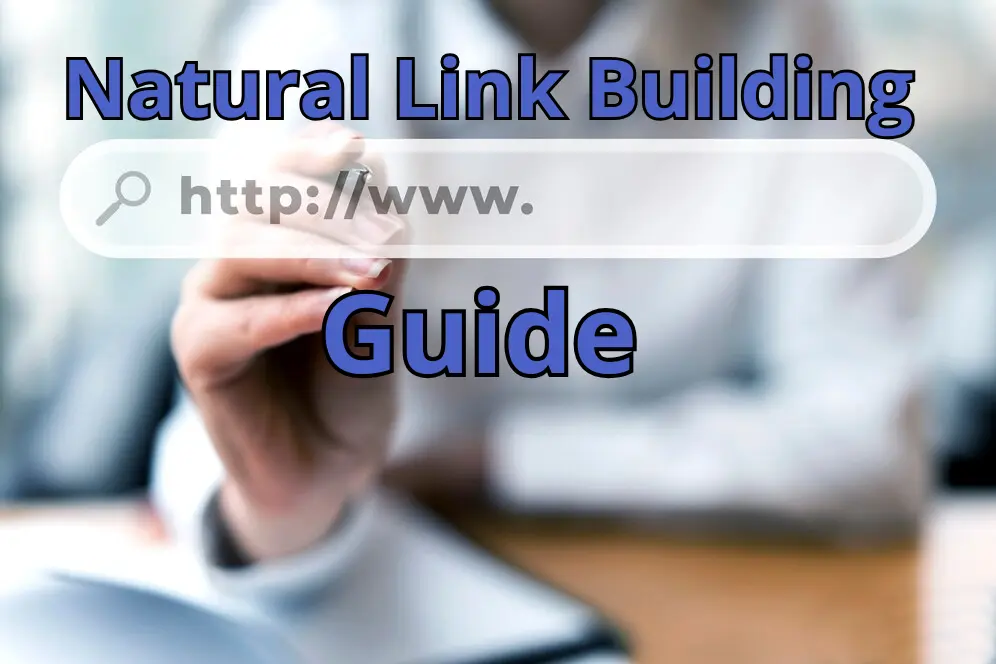Demystifying SEM and SEO: Fundamental Concepts

Understanding the difference between search engine marketing and search engine optimization begins with grasping their fundamental concepts.
SEO (Search Engine Optimization) refers to the organic process of optimizing your website to rank higher in unpaid search results. It involves technical adjustments, content creation, and link building strategies that improve your site’s relevance and authority in relation to specific search queries.
In contrast, SEM (Search Engine Marketing) encompasses paid strategies to increase visibility in search results. While SEM includes SEO, it primarily focuses on paid advertising through platforms like Google Ads where you bid on keywords to place ads in prominent positions on search engine results pages (SERPs).
The distinction becomes clearer when examining their approaches:
- SEO generates traffic through unpaid, organic rankings and requires ongoing optimization
- SEM includes paid advertising with immediate visibility but stops when you stop paying
- SEO results build gradually over months while SEM provides instant traffic
- SEO typically delivers 53.3% of website traffic versus 27% from paid search according to BrightEdge research
Marketers often use both SEM and SEO simultaneously, with SEO serving as the foundation for long-term growth and SEM providing immediate visibility for competitive keywords or time-sensitive campaigns.
Key Takeaways
| Key Point | Details |
|---|---|
| SEO focuses on organic traffic | Search Engine Optimization involves improving website visibility without direct payment, utilizing techniques such as content creation and link building. |
| SEM leverages paid advertising | Search Engine Marketing includes paid strategies that deliver instant traffic through bidding on keywords in platforms like Google Ads. |
| SEO results take longer to materialize | Significant improvements from SEO can take 3-6 months, whereas SEM provides immediate visibility upon launching ads. |
| These strategies can be complementary | Using both SEO and SEM together optimally balances long-term growth with instant results in digital marketing. |
Key Differences Between Search Engine Marketing and Search Engine Optimization

The difference between search engine marketing and search engine optimization extends beyond basic definitions into several critical operational aspects:
Cost Structure
SEO is investment-based while SEM requires direct payment. SEO demands investment in content creation, technical improvements, and link building with no per-click costs. Conversely, SEM operates on paid models like pay-per-click (PPC) where you’re charged each time someone clicks your ad.
Timeline and Results
SEO typically takes 3-6 months to show significant results as algorithms need time to recognize and reward optimization efforts. SEM delivers immediate visibility – ads appear as soon as campaigns are approved and funded.
Control and Predictability
SEM offers greater control over:
- Exact ad positioning
- Precise audience targeting by demographics, location, and behavior
- Specific budget allocation and spending limits
- Immediate ability to pause or modify campaigns
A 2022 study by Databox revealed that 68% of marketers find SEM more predictable for generating leads than SEO, which is more susceptible to algorithm changes.
The difference between SEM and SEO becomes particularly important when developing comprehensive digital marketing strategies that balance immediate results with long-term organic growth.
Strategic Applications: When to Choose SEM Over SEO (and Vice Versa)
Knowing when to prioritize search engine marketing versus search engine optimization can significantly impact your marketing outcomes and resource allocation.
When SEM Takes Priority
- Immediate visibility needs: Product launches, seasonal promotions, or event marketing require instant traffic that only paid search can deliver.
- Highly competitive keywords: When organic ranking is nearly impossible for valuable terms (like “insurance quotes” at $50+ per click), SEM provides visibility regardless of domain authority.
- Testing market viability: Before investing in extensive SEO, use SEM to validate keyword conversion potential and audience response.
- E-commerce businesses: Direct-response capabilities of SEM support product-specific campaigns with measurable ROI.
HubSpot research indicates businesses generate $2 in revenue for every $1 spent on Google Ads, making sem particularly effective for direct response objectives.
When SEO Delivers Better Value
- Limited marketing budget: Once ranking is achieved, SEO continues delivering traffic without ongoing per-click costs.
- Content-rich websites: Information-based businesses benefit from the trust and authority that organic rankings confer.
- Local business visibility: Local SEO often delivers better-qualified leads than broad SEM campaigns.
- Long-term market positioning: Building organic authority creates a sustainable competitive advantage.
The difference between seo and sem marketing becomes less relevant when you implement an integrated strategy where both complement each other’s strengths and compensate for weaknesses.
FAQs and Common Challenges: Navigating SEM and SEO Concerns
When implementing search strategies, marketers frequently encounter questions about the difference between search engine optimization and search engine marketing. Here are answers to the most common concerns:
Can SEO replace SEM completely?
While SEO can eventually generate significant traffic, completely replacing SEM isn’t advisable for most businesses. A Gartner study found that organizations using both strategies experienced 25% higher conversion rates than those using either approach in isolation.
How much budget should be allocated to each?
The ideal distribution varies by industry and objectives. E-commerce businesses typically allocate 60-70% to SEM and 30-40% to SEO, while content publishers often reverse this ratio. The key is matching allocation to your specific conversion goals and sales cycle.
What metrics best measure success?
SEM and SEO require different performance indicators:
- SEM metrics: Cost-per-click, conversion rate, quality score, impression share
- SEO metrics: Organic traffic growth, keyword rankings, backlink quality, page authority
How do algorithm changes affect each strategy?
SEO is more vulnerable to algorithm updates. When Google’s BERT update rolled out, 70% of SEO professionals reported ranking fluctuations, while SEM campaigns remained relatively stable with only targeting refinements needed.
The difference between SEM and SEO becomes most apparent during algorithm changes, where paid positions maintain visibility while organic rankings may temporarily fluctuate.
Future Trends in SEM and SEO: Evolving Digital Marketing Strategies
The landscape defining the difference between search engine marketing and search engine optimization continues to evolve rapidly. Several emerging trends are reshaping how marketers approach both strategies:
AI and Machine Learning Integration
Google’s increasing reliance on AI (like RankBrain and BERT) is transforming both SEO and SEM approaches. Natural language processing now requires content that answers user intent rather than simply matching keywords. For SEM, AI-powered bidding strategies are becoming the norm, with automated systems optimizing bids across thousands of keyword variables simultaneously.
Voice Search Optimization
With 41% of adults using voice search daily (PwC research), both SEO and SEM strategies must adapt to conversational queries. This trend favors natural-sounding content and question-based keywords over traditional phrase targeting.
Visual Search Revolution
Platforms like Google Lens and Pinterest Lens are creating new search paradigms where images replace text queries. This requires:
- Image optimization for SEO
- Visual product ads for SEM
- Schema markup to provide context for visual content
Reduced SERP Real Estate
Growth in featured snippets and zero-click searches is compressing available search result space. SEO now targets position zero (featured snippets) while SEM increasingly focuses on shopping and local ad formats that command visual attention.
Understanding what is the difference between sem and seo will become even more crucial as search boundaries blur between paid and organic with new ad formats and rich results.
Frequently Asked Questions
What is the main difference between SEO and SEM?
SEO (Search Engine Optimization) focuses on optimizing a website to improve its organic rankings in search results, while SEM (Search Engine Marketing) involves paid advertising to increase visibility in search results.
How does SEO impact website traffic compared to SEM?
SEO typically delivers 53.3% of website traffic through organic rankings, while SEM accounts for about 27% of traffic through paid ads that provide immediate visibility.
Can I rely solely on SEO for my marketing strategy?
While SEO can generate significant traffic over time, it’s generally not advisable to rely solely on it. Combining both SEO and SEM strategies often leads to higher conversion rates and more comprehensive visibility.
What factors should I consider when budgeting for SEO and SEM?
Budget allocation varies by industry and marketing goals. E-commerce businesses often allocate 60-70% to SEM and 30-40% to SEO. Understanding your sales cycle and conversion objectives can help in determining the best budget distribution.
Unlock the Power of SEO and SEM for Your Business
Are you feeling overwhelmed by the differences between Search Engine Marketing (SEM) and Search Engine Optimization (SEO)? You’re not alone! Many small to medium-sized business owners struggle with navigating the complexities of online visibility. With SEO accounting for 53.3% of website traffic and SEM providing that much-needed instant visibility, it’s crucial to find the right balance for your marketing strategy.

At WebDruids, we specialize in simplifying SEO services tailored to your specific needs. Our comprehensive offerings—including link building, local SEO, and SEO management—are designed to enhance your online presence and convert visitors into loyal customers. Imagine a world where you don’t have to wonder if Google likes your site; instead, you see measurable growth in your traffic and rankings!
Don’t wait until your competitors get ahead—let’s work together to harness the power of SEO right now! Visit us at https://webdruids.com to discover how we can help transform your digital marketing strategy and bring your business to new heights!






